The Leghorn chicken breed tops the list of most-reared birds in America.
You can attribute this to the number of Leghorn varieties and their productivity.
American farmers have reared this breed for over one hundred years. Whereas most rear the bird for egg production, a few consider it ornamental.
A Leghorn will hardly be overlooked in your flock if you raise poultry indiscriminately. And if new to this venture, you can grab a few Leghorns for your flock.
Here is more about Leghorn chickens, their characteristics, and how to raise them.
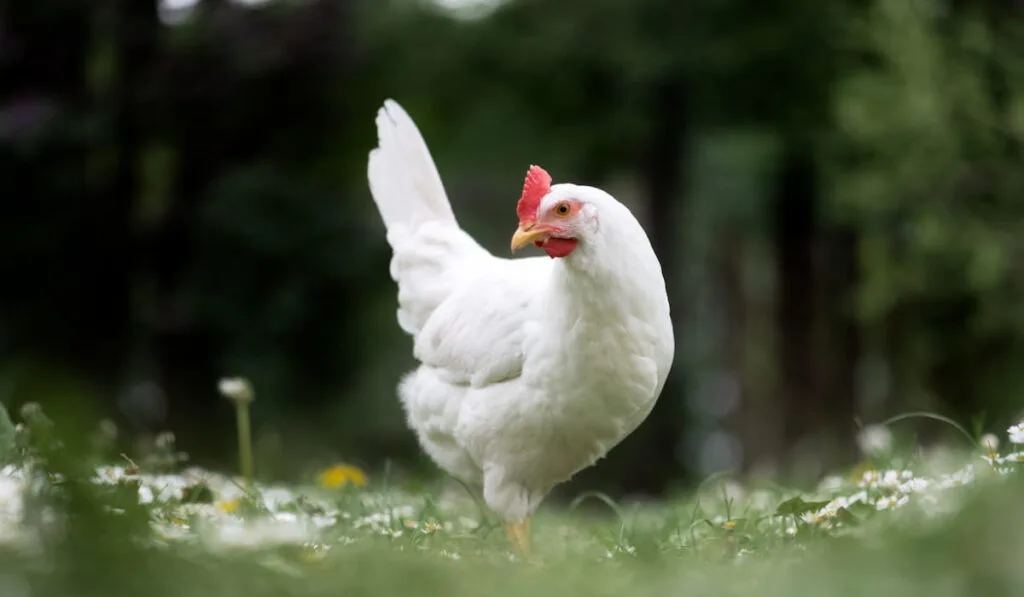
Table of Contents
History
Farmers have raised the Leghorn for more than five centuries. Although its origin is unknown, several Leghorn varieties were first spotted in northern Italy.
Early American farmers referred to the Leghorn chicken as “Italy”. This was because they mostly bred the Leghorn in the Tuscany region of northern Italy.
In the mid-1800s, Captain Gates of the US brought them to America. His first hatchery was at Mystic Harbor, where he bred the birds and the present Leghorn was born.
The former varieties had small bodies, and farmers reared them for eggs. However, the English farmers preferred a dual-purpose breed.
In an attempt to give the breed a more muscular and robust body, they crossed it with the Minorca.
The crossbreeding didn’t yield much as the breed remains light-bodied to date. Some farmers still appreciated it for egg production.
Present-day farmers and breeders rear Leghorn chickens for industrial purposes.
Description
The Leghorn is a small fowl that loves foraging. It flies higher than most chicken breeds and exudes style when walking.
Farmers worldwide rear this breed for egg production. It has unique characteristics which make it outstanding.
The ability to fly high, be noisy, roost in trees, and their single combs are some of the breed’s unique features. Explore more from the characteristics below.
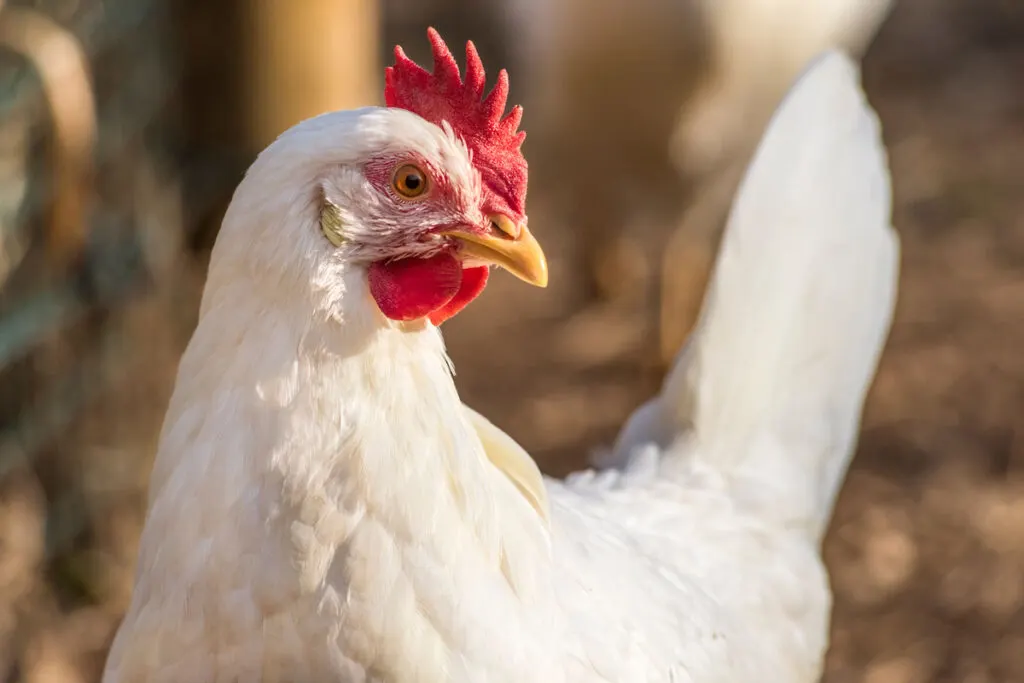
Characteristics
Appearance and Standard
The American Poultry Association (APA) has recognized the Leghorn family since 1874.
Contrary to many people’s belief that the Leghorns are all white, they come in various colors. However, white dominates. White feathers with a single comb is more popular than the other varieties.
The chicken breed has a red wattle with a single or rose comb and white earlobes.
Leghorn beaks are yellow, and eyes are red/orange. Each leg has four toes.
Like most chicken breeds, the leghorn has yellow skin.
Size
A mature Leghorn rooster is about 27.6 inches tall and weighs 5.7 pounds.
Their female counterparts are shorter and weigh about 6 pounds.
The male bantam Leghorns weigh 2.2 pounds while the females weigh 1.98 pounds.
Egg Color
The breed lays white-shelled eggs. You can spot the egg color by looking at their hanging earlobes.
Each egg weighs approximately 2oz. The egg size increases towards the end of a laying cycle.
Colors
Leghorns come in different plumage colors. White is the most popular.
Other colors include:
- Buff
- Black
- Red
- Brown
- Barred
- Silver
- Columbian
- Buff Columbian
Different countries have varying accepted colors for this breed. In the US, for example, black chicken with silver-gold duck wings and red-black tails are common in addition to white.
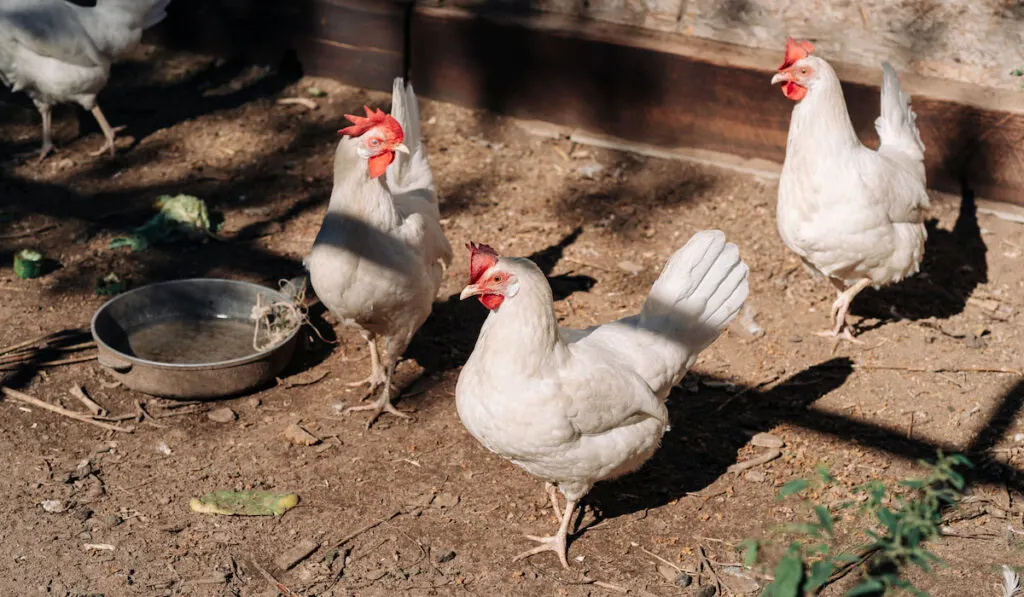
Temperament
Leghorns are not friendly, especially for beginners. They exude an independent aura and are flighty as they guard their territory.
If you allow them to roam around, they forage well for food. Farmers have described the breed as resourceful and intelligent because:
- They forage for food.
- They are assertive.
- The males roost in trees and high spots to guard females against danger.
These birds can be noisy, especially when frightened. Therefore, they are not great pets.
Besides, their protective nature makes them unfriendly and unsuitable for children and beginners.
And if you live in an urban area, this breed is not ideal because of the noise.
However, the above ‘unfriendly’ traits tend to reduce after continued close contact.
Once you rear them for a few months, you will get used to their independent and cautious nature.
Noise Level
Leghorns are flighty, nervous, and noisy. When handling them, they become cautious and protective and cannot rest in one spot.
Due to their high noise level, you may find it difficult to rear Leghorns in urban areas where you have close neighbors.
Lifespan
When raised under hygienic conditions and monitored well, Leghorns live for 5-7 years.
You can manage their food requirements since they eat sparingly and love foraging. This makes them cheap to raise.
Sexing
You can identify male and female Leghorns before maturity. Although they appear identical after hatching, you will observe differences in their body structure as they grow.
The following features help to distinguish between cockerels and pullets.
| Age | Cockerels | Pullets |
| Four weeks | The growth rate is slow and is lighter. | Comb and rattle are smaller. |
| Eight weeks | Learns how to crow. | No signs of crowing |
| Throughout | Grow faster and are heavier | The growth rate is slow and is lighter |
In addition to the above features, males tend to guard females against danger. You will see them perching on high spots to notify the pullets of impending danger.
Egg Laying
Leghorns start laying eggs when they are 16-22 weeks old. A single hen lays 4-5 eggs per week. A healthy hen can lay 280-320 eggs in one year, and they are productive for 4+ years.
A shelled egg weighs about 2 oz at the beginning of the laying cycle. Towards the end, the size and mass increases.
If you are looking for a breed to raise chickens for egg production, the Leghorn is ideal. In addition to the high number of eggs, you spend less on feed.
Besides, this breed is hardy and tolerates heat and cold well. This will save you expenses on treatment.
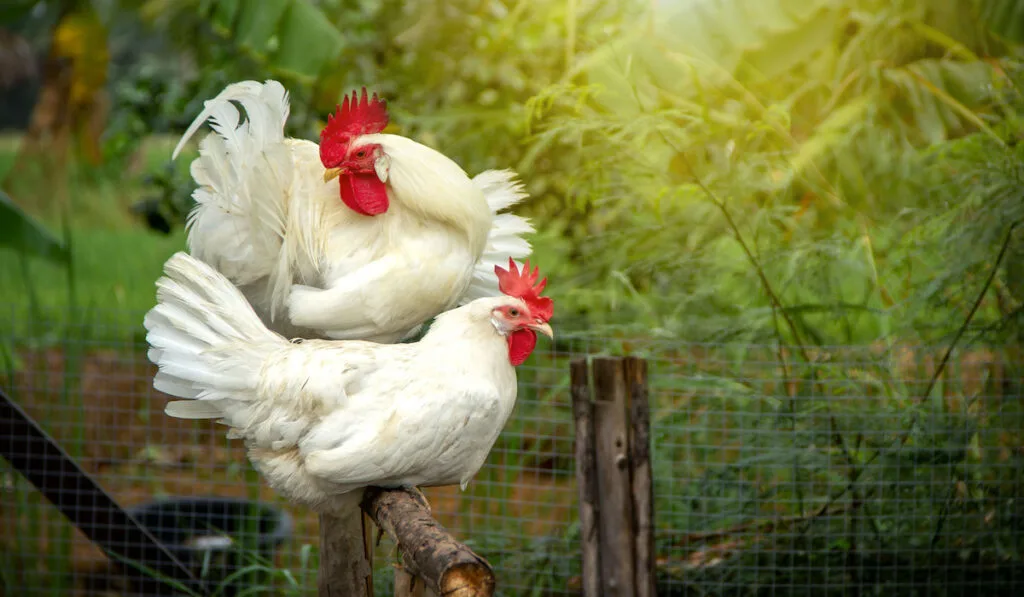
Raising
Leghorns are among the easiest chicken breeds to raise. They are independent and therefore require shallow monitoring.
Once you offer them a serene environment, they can survive under minimal care.
Their hardiness to heat and cold, protective nature, and moderate feeding makes them easy to raise.
Hatching
This breed’s hens are not the best sitters. Their activity and flighty personality make them poor brooders.
However, you can confine them during the brooding period, away from the noise.
If you want to hatch many eggs, use an incubator. You only need to set the right temperature and handle the eggs well for a near 100% hatching.
Feeding and Nutrition
This breed comprises light eaters. Therefore, feeding them is cheap.
If you allow them to free range, your expenditure on food decreases more. Furthermore, they gain more nutrients while foraging for quality products.
Since they are layers, you should give them 16%-layer feed.
You should also give them oyster shells and insoluble grit in different containers for quality shell formation.
Clean water is essential for healthy Leghorns. You need one quart of water for every four Leghorns.
To prevent diarrhea and other infections, always replace contaminated water.
A good portion of carbohydrates supplies energy to keep your flock warm and enhance adaptability to cold weather.
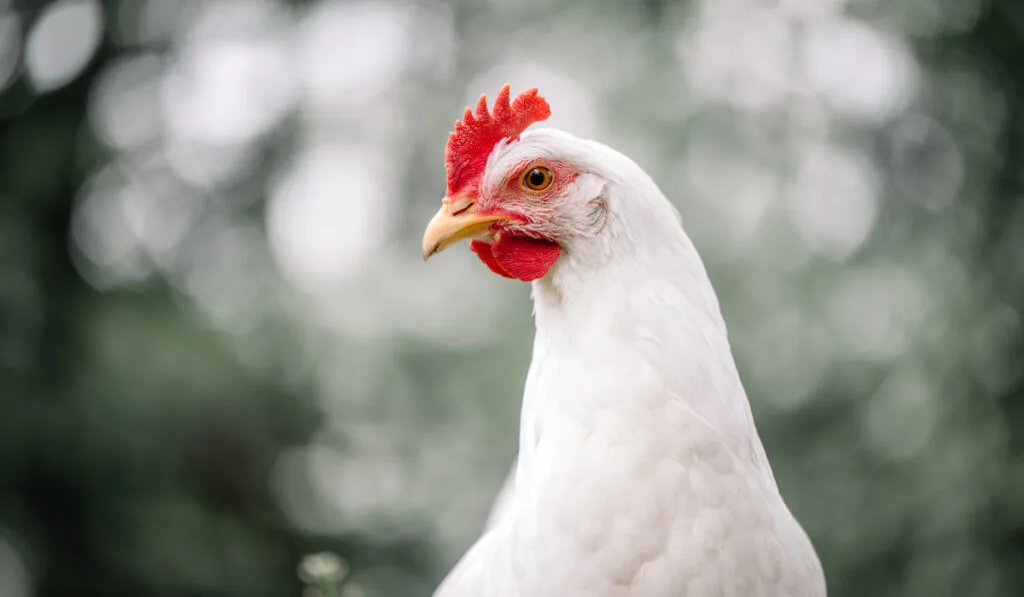
Housing
This breed requires 4 square feet of coop space per bird thanks to their small bodies.
The space is enough for activity, given their restless nature.
And for females that want to roost, an 8-inch space is enough.
The standard nesting box measures 12×12 inches. This space is ideal for comfort and allows for minimal movement to ensure the hen remains in position.
In all seasons, ensure you keep the chicken coops clean. Doing so will save you the hassle of treating your flock after a parasite attack.
Wash the nest boxes with water and soap and apply disinfectant regularly.
Note that Leghorns tolerate confinement but enjoy roaming. Therefore, allow them to roam regularly, but keep your yard fenced.
Also, discourage them from roosting in trees because they are good flyers. You can do this by keeping them in their coops until they get used to it.
Health Issues
Leghorns are active and hardy birds. Their tolerance to cold and heat is admirable.
During winter, their combs and wattles can get frostbitten. However, you can prevent this by applying petroleum jelly on these parts before they go roaming.
You have little to worry about when it comes to their health because these birds are resistant to most poultry diseases.
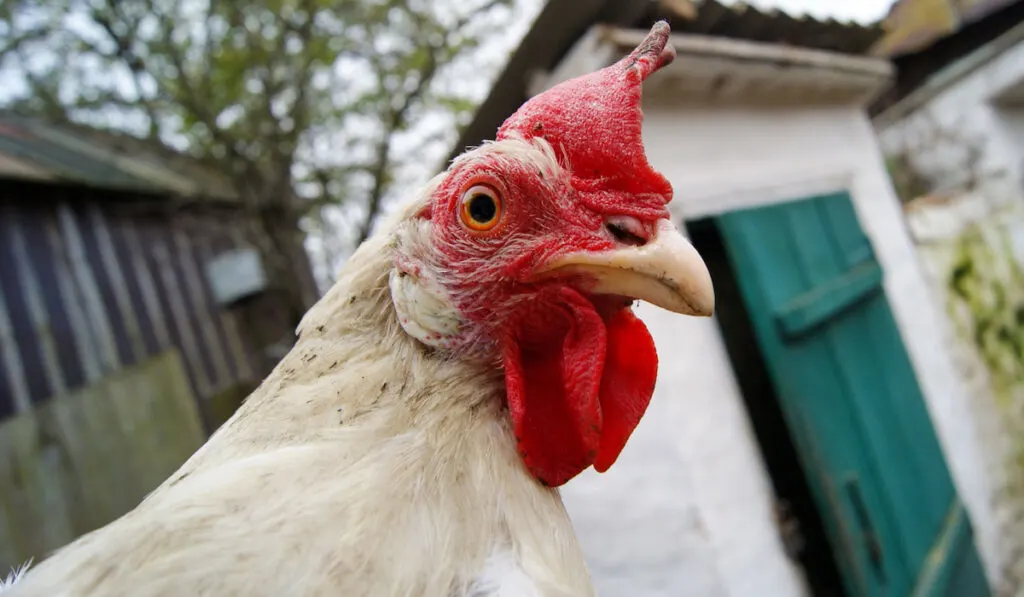
Where to Buy Leghorn Chicken?
Being the most reared breed, finding Leghorn chicken to buy is easy. You can visit any hatchery near you or order from online stores.
Before buying, learn how to identify Leghorns and distinguish between males and females.
Although the cost varies depending on your supplier, a mature male Leghorn costs $2-3 while a female costs $4-5.
The variation in cost results from productivity. Since the breed is reared for eggs, the hens cost more.
Final Thoughts
The Leghorn chicken breed is ideal for farmers keen on egg production. However, you need ample space away from neighbors given their flighty and noisy nature.
Because of its characteristics, this breed is best suited for the countryside, where residential areas are far apart.
Given its hardy nature and tolerance to varying weather conditions, you can raise Leghorns in any climatic region.
Resources
- https://breeds.okstate.edu/poultry/chickens/leghorn-chickens.html?Forwarded=afs.okstate.edu/breeds/poultry/chickens/leghorn/
- https://www.thehappychickencoop.com/leghorn-chicken/
- https://www.britannica.com/animal/chicken
- https://backyardpoultry.iamcountryside.com/chickens-101/all-about-leghorn-chickens/
- https://www.chickensandmore.com/leghorn-chicken/#Feeding
- https://blog.mcmurrayhatchery.com/2018/08/02/gail-damerow-discusses-a-hens-laying-cycles-and-life-span/
